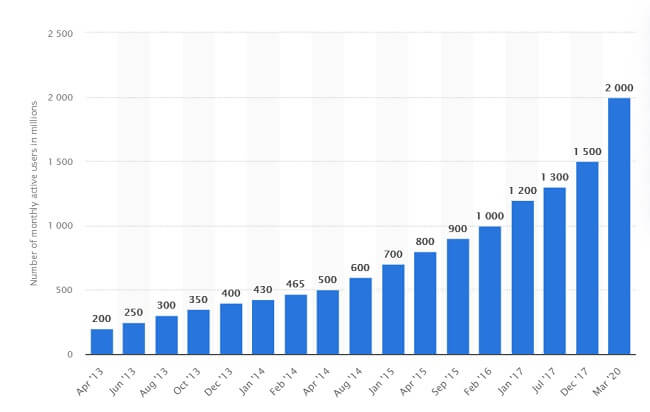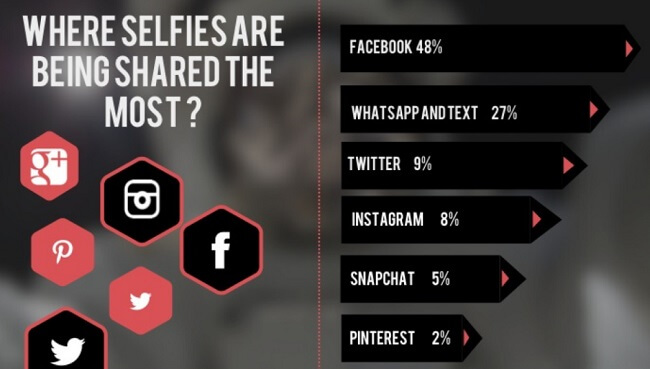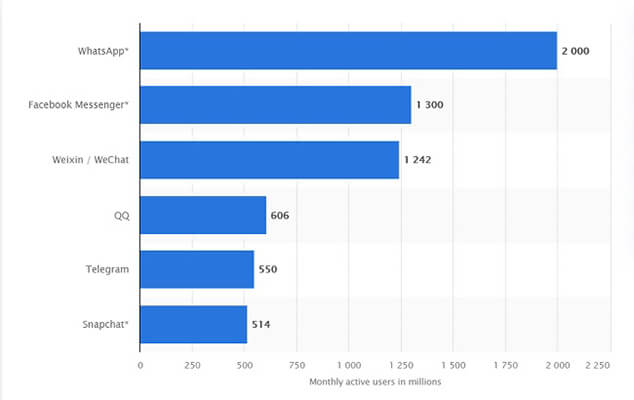34 Latest WhatsApp Statistics For 2024: The Complete Guide

As the most popular messenger app in the world, you’d be hard-pressed to find someone who hasn’t already heard of WhatsApp.
In fact, the chances are, you probably have it installed on your phone as you’re reading this – but how much do you really know about it?
In this post, we’ll be sharing the latest WhatsApp statistics and trends about this mobile messenger service. By the end of the post, you’ll know pretty much everything there is to know.
Editor’s top picks – WhatsApp statistics
These are our most interesting statistics about WhatsApp:
- WhatsApp currently has more than 2 billion active users. (Source: Statista1)
- WhatsApp is the 3rd most used social platform in the world. (Source: Hootsuite/WeAreSocial)
- Use of WhatsApp by e-commerce businesses also increased by 352%. (Source: Zendesk)
WhatsApp usage statistics
First, let’s take a look at some WhatsApp statistics that tell us more about WhatsApp’s user base and the ways in which they interact with the app.
1. WhatsApp currently has more than 2 billion active users
Think about that for a second. There are a little over 7.5 billion people on earth, which means more than a quarter of the entire global population uses WhatsApp.
However, it wasn’t always that way. Back in April of 2013 (before WhatsApp was acquired by Facebook), it had just 200 million monthly active users. By February 2016, that had increased fivefold to 1 billion. And in the 4 years since then, it has doubled again.

Source: Statista1
2. Around 100 billion WhatsApp messages are sent each day…
According to a recent Tweet made by the CEO of WhatsApp Will Cathcart, WhatsApp is able to deliver around 100 billion messages every day. That’s around 50 messages for every active user.
This figure was probably higher in 2020 than ever before given that, in light of the pandemic and national lockdowns, we’ve all had to increasingly rely on messaging to communicate with our friends, family, and colleagues.

Source: Twitter1
3. … And over 100 million voice calls made
That’s around 1,100 calls per second. While still a very large figure, it’s interesting to note that it’s significantly less than the number of messages sent each day. Only one voice call is made per thousand messages sent on WhatsApp, roughly speaking.
This tells us that while WhatsApp might have conquered the instant messaging world, it’s still struggling to make inroads in the voice call sector, which is dominated by mobile networks. Verizon alone reports handling around 800 million phone calls per day, which is 8x those made via WhatsApp.
Source: WhatsApp blog
4. The average Android WhatsApp user spends around 19 hours on the app per month
This makes it the second top media mobile app by global cumulative time spent, beaten only by Facebook. It only barely missed out on the top spot too; the average user spends 19.4 hours per month on WhatsApp, compared to 19.5 hours on Facebook.
Instagram ranked a distant third with the average time spent per user just 10.3 hours per month. It’s also worth noting that WhatsApp Business also ranked in the top 10, with users spending 9.3 hours on the app each month on average.
Source: Hootsuite/WeAreSocial
5. WhatsApp is the 3rd most used social platform in the world
To add to WhatsApp’s list of accolades, it’s also the third most popular social platform globally. With 2 billion users, WhatsApp follows closely behind YouTube (2.2 billion users) and Facebook (2.7 billion users). Its closest rival in the marketplace, Facebook Messenger, lags far behind with just 1.3 billion users.
Whether or not WhatsApp will remain so popular or be overtaken by new growing social platforms like TikTok remains to be seen, but given that it’s still growing quickly, it looks like it’s going to continue to be a big part of the cultural zeitgeist for years to come.

Source: Hootsuite/WeAreSocial
6. The majority of WhatsApp users are male
Interestingly, WhatsApp’s user base doesn’t align with the expected 50/50 gender split. Instead, it’s skewed slightly towards male users. Males represent 54.5% of the total user base, and female users make up just 45.5%.
This has implications for marketers hoping to use WhatsApp as a marketing communication channel and may suggest it’s best suited to businesses targeting a primarily male demographic.

Source: Hootsuite/WeAreSocial
7. WhatsApp is used in 180+ countries
As this statistic shows, WhatsApp is a truly global platform. The development team chose to focus on building a reliable messaging service that would work fast and reliably no matter where you are in the world, and it looks like they succeeded. There are only 195 countries on planet earth, and there are WhatsApp users in 180 of those.
Source: WhatsApp
8. India has more WhatsApp users than anywhere else in the world…
There are 390 million WhatsApp users in India, making it the country with the most WhatsApp users. To put that into perspective, the US (which ranks third) has just 75.1 million users – less than a fifth of the number of users in India.
You might think this is simply due to the fact that India has a much larger population than the US (1.36 billion compared to 328 million), but you’d be wrong.
Even when we factor in the difference in population, WhatsApp still seems to be much more popular in India than in the US. Around 0.29% of the population of India use WhatsApp, compared to just 0.23% of the population of the US.
Source: Business Insider/Insider Intelligence
9. … closely followed by Brazil, which is home to over 108 million WhatsApp users
Brazil comes in second place, with 108.4 million WhatsApp users. Interestingly though, when we compare this to the population size, it seems WhatsApp is much more popular in Brazil than in both India and the US.
0.51% of the entire population of Brazil use WhatsApp, compared to just 0.29% in India and 0.23% in the US. So, what’s the reason for this difference in regional market penetration?
Well, it could have something to do with the fact that countries like Brazil and India are mobile-first countries. Compared to the US, people in Brazil spend much more time on mobile devices than on desktops. Therefore, it makes sense that mobile apps like WhatsApp would be more popular.
Source: Business Insider/Insider Intelligence
10. Hispanic People are far more likely to use WhatsApp than any other group in the US
This is one of the most notable demographic differences in WhatsApp usage. 46% of Hispanic Americans say they use WhatsApp, compared to just 23% of Black Americans and 16% of White Americans.
So, what gives? Well, the reason behind WhatsApp’s popularity amongst Hispanic users is unclear, but probably has something to do with the platform’s popularity in Latin American countries.
In Latin American countries, mobile costs are amongst the highest in the world due to a lack of competition between network providers. As WhatsApp offers Wi-Fi messaging that’s free, residents of countries where mobile carrier costs are high often turn to WhatsApp to avoid high SMS fees.
Source: Pew Research Center
Related Reading: 30 Latest SMS Marketing Statistics, Facts, And Trends.
11. 30% of WhatsApp users are aged between 30 and 49
This makes it the top age bracket amongst WhatsApp users. For comparison, 24% of those aged 18-29 in the US say they use WhatsApp, 23% of those age 50-64, and only 10% of those aged 65+.
While slightly skewed towards younger audiences, WhatsApp seems to appeal to all ages. A much greater proportion of those aged 30-64 use WhatsApp than platforms like Snapchat, Twitter, and TikTok.
Source: Pew Research Center
12. WhatsApp was the 13th most searched Google Query during 2020
Again, that’s pretty impressive, especially given that you’d have thought most people would search for WhatsApp on mobile app stores, rather than search engines like Google. It just goes to show just how popular WhatsApp was last year.
Source: Hootsuite/WeAreSocial
13. 33% of WhatsApp users are college graduates
This is another interesting piece of data regarding WhatsApp’s user demographics. For some reason, the app seems to be much more popular amongst college graduates. 33% of those with at least a college education use the app, compared to 16% of those with some college education, and 20% of those with a high school education or less.
Source: Pew Research Center
14. 29% of WhatsApp users earn over $75000 per year
Perhaps related to the above statistic, 29% of US adults that earn over $75k per year say they use WhatsApp. This makes it the most popular income bracket amongst WhatsApp users. In comparison, only 23% of those that earn under $30K per year, 20% of those that earn between $30K and $49,999, and 10% of those that earn $50K-74,999 say they use the app.
Source: Pew Research Center
15. 50% of WhatsApp users access the platform at least once a day
WhatsApp users tend to be very active on the platform. Half of them check the app every single day, and the vast majority (91%) access it at least once per month.

Source: Statista2
16. 20% of US adults use WhatsApp
According to data from Marketing Charts, around a fifth of adults in the US use WhatsApp. While that’s certainly impressive, it also shows that, with 80% of the adult population not yet using the app, WhatsApp has a lot of room left for growth.
Source: Marketing Charts
17. 27% of all selfies are shared using WhatsApp
Facebook seems to be the first place to go when you snap a selfie that you want to share, but WhatsApp comes in second place. 27% of selfie-takers share their snaps on WhatsApp and text, compared to 48% on Facebook and just 8% on Instagram.

Source: Visually
18. WhatsApp was downloaded 96 million times in 2020
According to Sensor Tower, WhatsApp was downloaded almost 100 million times in 2020. That’s makes it the 2nd most downloaded nongame app after TikTok.
Source: Sensor Tower
19. WhatsApp is the most popular messaging app in the world
With over 2 billion users, WhatsApp takes the top spot as the most popular messaging app in the world. Runners up include Facebook Messenger, and Chinese messaging apps WeChat and QQ.

Source: Statista3
WhatsApp business statistics
Next, we’ll take a look at some WhatsApp business statistics. These stats tell us more about the WhatsApp Business app, as well as how business owners can use WhatsApp for business purposes, and why they might want to.
20. WhatsApp Business has over 50 million users
WhatsApp Business is an app dedicated to businesses that want to utilize WhatsApp to stay in touch with their customers. It provides businesses owners with messaging tools, categorization options, and a business profile that can all be used to turn WhatsApp into a legitimate business tool. Since its inception, the app has gained a lot of steam and now has over 50 million users.
Source: DataReportal
21. The app is ranked #17 in the business app category on the app store
WhatsApp Business is fast becoming a must-have tool, particularly for e-commerce businesses. This year, it was ranked in the top 20 businesses apps on the Apple app store. The app is listed amongst essential business apps like Microsoft Teams and Zoom Cloud meetings.

Source: Apple
22. Using WhatsApp Business can streamline customer service by 225%
One of the main benefits of using WhatsApp business is how easy it makes it to communicate with your customers on a 1-1 basis. According to statistics published by Tyntec, WhatsApp Business speeds up customer service by 225%. It’s also reported to increase sales by 27% and improve conversion rates by 20%.
Source: Tyntec
23. WhatsApp Business API messages have a 99% open rate
One of the major benefits of using WhatsApp business is that users are much more likely to open a WhatsApp message than they are to open an email. According to Telemedia, WhatsApp API messages have a whopping 99% open rate, and even better, the response rate is just less than 50%.
Source: Telemedia
24. 40 million WhatsApp users view the business catalogs in the app monthly
WhatsApp is fast becoming a great place for businesses to interact with their customers. Many users are already aware of the business-related features available on the platform. In fact, around 40 million users make use of the business catalog features every month to find products and services.
Source: Facebook)
25. 175 million people a day use WhatsApp to contact businesses
According to Will Cathcart the Head of WhatsApp, WhatsApp is an essential social media channel for businesses. In a Tweet published in Jan 2020, Cathcart shared that 175 million people per day use WhatsApp to contact businesses, making it an important customer service channel that all businesses should take into account.

Source: Twitter2
26. The most popular reason for contacting businesses on WhatsApp is for customer support
According to figures published on Statista, the most common reason people contact businesses on WhatsApp is for customer support. Other reasons for contacting businesses via WhatsApp include pre-sales support, community engagement and, raffles and games.
As you can see, by combining pre-sales support, customer service, and after-sales brand awareness building, businesses can use WhatsApp to nurture customers at each stage of their sales funnel.

Source: Statista4
WhatsApp growth and revenue statistics
WhatsApp has come a long since it was first released more than a decade ago. Here are some statistics that reveal more about WhatsApp’s growth and how much the app generates in revenue.
27. Facebook purchased WhatsApp for around $19 billion in 2014
WhatsApp grew quickly in popularity when it was launched back in 2009, and it quickly caught the attention of the biggest social media company in the world, Facebook.
In order to acquire WhatsApp, Facebook made a record-breaking deal with the founders, paying almost $20 million in 2014. Since the acquisition, WhatsApp has continued to grow in popularity, and Facebook has made a range of changes including the implementation of WhatsApp Business.
Source: Forbes1
28. WhatsApp made over $5 billion in 2020
$19 Billion seems like a lot for Facebook to spend on a fledgling messaging app, but it seems that they had the right idea.
Although Facebook doesn’t officially release revenue figures for WhatsApp as an individual enterprise, it’s estimated that the company brought in around $5 billion in 2020. This means that if figures remained consistent, Facebook will have earned back their record-breaking investment in just 4 years.
However, while $5B isn’t exactly chump change, it’s also not as high as it could be. WhatsApp’s revenue has never fully matched up with its reach, given that it doesn’t bring in any advertising revenue. Facebook is pursuing new potential revenue streams for WhatsApp, such as the introduction of a new shopping carts feature.
Source: Forbes2
29. The first investment in WhatsApp was only $250,000 in 2009
WhatsApp was started from the ground up by two ex-Yahoo employees. The pair were keen to get involved in a digital project but had no idea where it may lead.
In order to get their project off the ground, the paid rallied for investment from some of their ex-coworkers, who invested just a quarter of a million dollars combined. This may seem like a lot, but the company sold for 76,000x this original investment just 6 years later. Not bad right?
Source: FeedDough
30. WhatsApp used to monetize the app by charging a $0.99 subscription fee
When WhatsApp first started out, they were unsure of the best way to make the most of the platform. The creators were keen to avoid the pay-per-message model that was used by SMS providers. To combat this, the team devised a subscription model.
Each user was charged $0.99 for lifetime access. Despite the charge, people were quick to adopt WhatsApp as it allowed users to send picture messages for free, which was a huge bonus at the time. However, when the company was acquired by Facebook, the model was scraped and the app became free to use.
Source: FeedDough
31. WhatsApp saw the most growth of all social apps during the Covid-19 pandemic
At a time many businesses were desperately trying to find a way to function given the new restrictions in place, many digital businesses thrived. The majority of social apps including Zoom, Skype, TikTok, and more saw huge increases in downloads. However, it was WhatsApp that saw the most growth at this time.
Not only were users taking advantage of the messaging functions of WhatsApp, but they were also using it to make calls. In April 2020, users were making about 15 billion minutes of WhatsApp calls per day.
Source: Kantar
32. Usage increased by 40% in March of 2020
As nations across the world plunged into lockdowns, people scrambled to find ways to stay connected with their loved ones digitally. In the same way that programs like Zoom saw rapid growth at this time, so did WhatsApp. At the height of the pandemic, WhatsApp became the messenger app of choice for people worldwide and usage increased by almost half.
Source: TechCrunch
33. Use of WhatsApp by e-commerce businesses also increased by 352%
In the same way, that general users flocked to WhatsApp to stay connected during the pandemic, so too did e-commerce businesses.
According to figures published by Zendesk, e-commerce usage increased by almost 400%. WhatsApp Business offers a great option for E-commerce businesses looking to provide responsive customer support in a way that is accessible for the average consumer. It’s easy-to-use for both the business and the customer.
Source: Zendesk
34. WhatsApp saw a 17% downturn in downloads in January 2021
In January 2021, WhatsApp planned to roll out a new privacy policy that sparked major backlash amongst users. The move was intended to allow WhatApp more freedom to share data with Facebook and eventually improve monetization.
However, confusion and controversy surrounded the update, and WhatsApp was forced to extend the rollout date in an effort to help users better understand the changes. The update was extended to March 2021 instead.
Source: Wall Street Journal
Sources
Final thoughts
Those are all the WhatsApp statistics we have for you today. We hope you found them helpful and interesting!
Want to find out how WhatsApp compares to other popular social platforms? Check out our roundups of the latest Instagram stats, Facebook stats, and TikTok stats!
Related Reading: The Best Social Media Management Tools To Save You Time.
